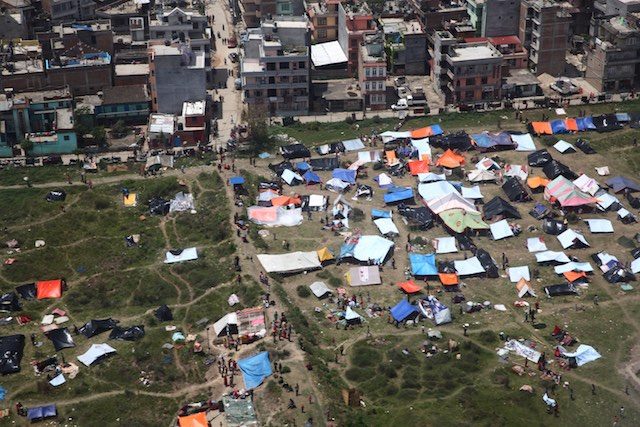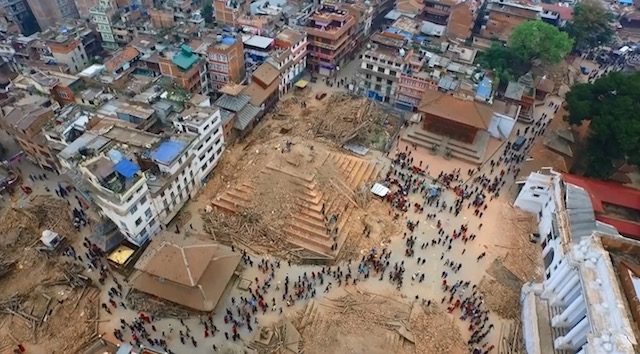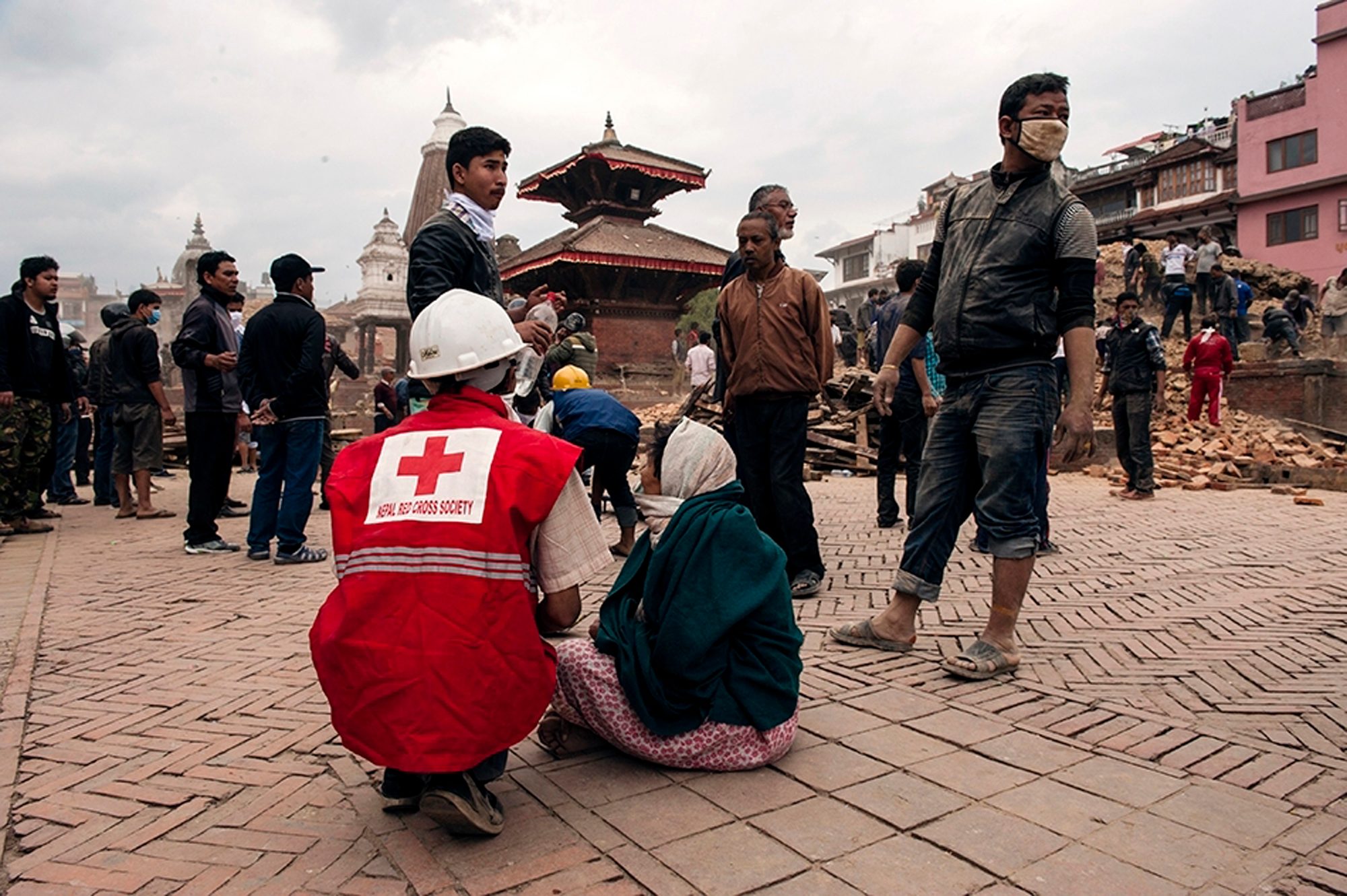SUMMARY
This is AI generated summarization, which may have errors. For context, always refer to the full article.

KATHMANDU, Nepal (UPDATED) – Hundreds of thousands of Nepalis spent another night in the open Monday, April 27, after a massive quake which killed more than 4,300, as officials warned the final toll could rise sharply once rescuers reach cut-off areas.
With fears rising of food and water shortages, Nepalis were rushing to stores and petrol stations to stock up on essential supplies in the capital Kathmandu, left devastated by Saturday’s (April 25) 7.8-magnitude quake.
The death toll from the devastating earthquake has risen to 4,310, the home ministry said. A further 7,953 people are now known to have been injured, said ministry spokesman Laxmi Prasad Dhakal.
Officials had previously put the death toll at 4,010, while nearly 100 people have also been killed in neighbouring countries.
More than 90 people have been killed in neighboring India and China while a further 7,500 people were injured in Nepal.
But senior disaster management official Rameshwor Dangal said the toll in Nepal could jump once rescuers discovered the full extent of devastation in villages outside Kathmandu.
“Rescue operations are underway, and in many places where buildings have collapsed there might be people trapped,” Dangal, the home ministry’s national disaster management chief, told Agence France-Presse.
“We are also in the process of getting information from villages, and these will add to the death toll.”
Families who work in Kathmandu were packing onto buses, some even sitting on the roofs, leaving the city, many for their home villages to determine the damage there.
Mothers clutching children and men hauling bags were seen bargaining with drivers of the many buses clogging the roads out of the capital.
The exodus came as international rescue teams with sniffer dogs raced to find survivors buried in rubble, and teams equipped with heavy cutting gear and relief supplies landed at the nation’s only international airport.
Elisabeth Byrs, a spokeswoman for the UN’s World Food Programme, told Agence France-Presse the agency would launch a “large, massive operation” with the first plane carrying rations set to arrive on Tuesday, April 28.
Pledging $10 million in relief to help the victims, US Secretary of State John Kerry said he had been shocked by the “gut-wrenching” images of the death and destruction.
Speaking at the same press conference, Japan’s Foreign Minister Fumio Kishida said that Tokyo was sending some $8 million in aid to Nepal.
Hunkered in tent camps
Across the capital, Nepalis were hunkered down for the night in makeshift tents in parks and other open spaces, many having lost their houses and others too terrified to return home after several powerful aftershocks.
“This is a nightmare. Why don’t these aftershocks stop?” asked 70-year-old Sanu Ranjitkar, clutching her dog and with an oxygen mask strapped to her face as she sat under a tarpaulin.
With just plastic sheets to protect them from the elements, many were desperate for aid and information on what to do next.
“There is just too much fear and confusion,” said Bijay Sreshtha, who fled to a park with his three children, wife and mother when the quake hit.

Fears were rising of a disease outbreak in the multitude of camps that have sprung up around the city.
“Right now, it is important to prevent another disaster by taking precautions against an outbreak of diseases among the survivors,” army official Arun Neupane told reporters.
Long queues formed outside petrol stations while supermarkets were seeing a run on staples such as rice and cooking oil.
A government official said tonnes of clean water and other essential supplies were needed for survivors as well as stepped-up search and rescue efforts outside the capital.
“We need more helicopters for our rescue operations in rural areas,” home ministry spokesman Laxmi Prasad Dhakal told Agence France-Presse.
“We also need supplies of essential goods such as food and clean water to provide relief for survivors.”
Rescue on Everest
The quake triggered an avalanche on Mount Everest which buried part of base camp in a cascade of snow and rock, killing at least 18 people Saturday on the world’s highest mountain.
The US State Department confirmed Monday that two of its citizens were among those killed on the mountain, adding that they were aware of reports that two further Americans had died.
Australia’s Foreign Minister Julie Bishop confirmed that an Australian woman also perished on Everest.
Rescue helicopters on Monday airlifted climbers from higher altitudes on the mountain where they were stranded above crevasses and icefalls, after evacuating scores of seriously injured from base camp the day before.

Hundreds of mountaineers had gathered at Everest at the start of the annual climbing season, and the real scale of the disaster there has been difficult to evaluate so far.
Reconstruction efforts in impoverished Nepal could cost more than $5 billion, or around 20 percent of the country’s GDP, according to Rajiv Biswas, Asia Pacific chief economist at business research firm IHS.
Nearly a million children living in affected areas are in urgent need of humanitarian assistance, UNICEF said.
Nepal’s army said crews trying to rescue those trapped in the rubble of high-rise buildings in the historic centre of Kathmandu were being hampered by a lack of specialized equipment.
“We need more equipment that can detect sounds and help track survivors,” Colonel Naresh Subba told reporters.
‘She was my everything’
In Kathmandu’s Balaju neighborhood, one father endured the agony of watching police pull the body of his daughter from the rubble of their home after using a combination of hammers and bare hands.
“She was my everything,” said Dayaram Mohat as he collapsed in grief on hearing the news of his 14-year-old daughter Prasamsah’s death.
The Nepalese rescuers were being joined by hundreds of foreign aid workers from countries including China, India and the United States.
Hospitals have been overwhelmed, with morgues overflowing and medics working flat out to cope with an endless stream of victims suffering trauma or multiple fractures.
The quake’s epicenter was around 45 miles (73 kilometres) east of the town of Pokhara, the country’s centre for adventure sports. An Agence France-Presse correspondent reported the town had been largely unaffected and tourists were continuing their holidays.
Nepal and the rest of the Himalayas, where the Indian and Eurasia tectonic plates collide, are particularly prone to earthquakes.
A 6.8 magnitude quake hit eastern Nepal in August 1988 killing 721 people, and a magnitude 8.1 quake killed 10,700 people in Nepal and India in 1934. – Bhuvan Bagga and Paavan Mathema, AFP / Rappler.com
Add a comment
How does this make you feel?
There are no comments yet. Add your comment to start the conversation.